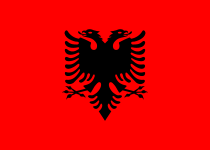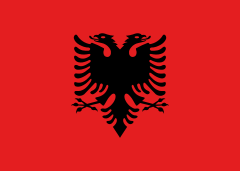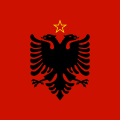Please tell us which country and city you'd like to see the weather in.
 |
|
| Name | Albania |
|---|---|
| Use | National flag |
| Proportion | 5:7 |
| Adopted | 1912 (original flag)
7 April 1992 (current flag) |
| Design | A silhouette of an open-winged bicephalated eagle on a red field. |
The flag of Albania (Albanian: Flamuri i Shqipërisë) is a red flag, with a silhouetted black double-headed eagle in the centre, that represents the sovereign state of Albania located in the Balkans.
Contents |
History [link]
The double-headed eagle is the national symbol of the Albanians and was used for heraldic purposes during the Middle Ages by a number of Albanian noble families, including the Kastrioti, whose most famous member was George Kastriot Skanderbeg. The Kastrioti's coat of arms, depicting a double-headed eagle on a red field, became famous when he led a revolt against the Ottoman Empire that resulted in brief independence for some regions of Albania from 1443 to 1478. The double-headed eagle on the flag is borrowed from the banner of the Byzantine Empire (specifically the emblem of the Palaiologoi dynasty).[1][2]
The symbol of the double-headed eagle was re-used by Albanian nationalists during the late 19th and early 20th centuries as a symbol of their campaign for their country's independence from the Ottoman Empire.[1][3] On 28 November 1912, the Albanian Declaration of Independence was proclaimed in Vlora and the flag, raised by Ismail Qemal, was adopted as the symbol of the new nation.[1][3]
The Albanian flag has gone through a number of changes over the years as different regimes have modified it. During the reign of King Zog (r. 1928–1939), a crown was added to the flag and was replaced by two axes during the Italian occupation of Albania. After World War II, the communist regime added a five-pointed golden star, which was removed on 7 April 1992 after the communist government in Albania collapsed.[3]
Albania's maritime flags—the civil ensign and the naval ensign—are both different from the national flag. The civil ensign consists of three horizontal bands of red, black, and red. The naval ensign is similar to the national flag, except that the eagle is on a white field, and the lower portion of the flag has a red stripe. The eagle of the flag of Albania is depicted on the reverse of the Albanian five lekë coin, issued in 1995 and 2000.[4]
Beginning in 1969, the flag of Albania was widely unofficially flown in Kosovo by the country's ethnic Albanian population.[5] It was the symbol of the unrecognised Republic of Kosova during the 1990s. The current independent state of Kosovo uses a different flag that was designed to avoid any symbols associated with a particular ethnic group.
Gallery [link]
Chronological [link]
-
Flag of the Principality of Arber.JPG
Flag of the Principality of Arbër (1190–1255).
-
Flag of the Princedom of Albania (1368–1444).
-
Flag of the League of Lezhë introduced by Skanderbeg (1444–1479).
-
Flag of the Provisional Government of Albania (1912–1914).
-
Flag of the Principality of Albania (1914–1920).
-
Flag of the Principality of Albania (1920–1925) and the Albanian Republic from (1925–1926).
-
Flag of the Albanian Kingdom (1928–1934).
-
Flag of Albania under Italy (1939–1943).
-
Flag of Albania under Nazi Germany (1943–1944).
-
Flag of Democratic Government of Albania (1944–1946).
-
Flag of Socialist Albania (People's Republic of Albania and People's Socialist Republic of Albania) (1946–1992).
Ensign and standard [link]
-
Insignia of the Royal Albanian Army
Other [link]
-
Latin (usually Albanian) Merchant Flag 1453-1793 during Ottoman Albania
-
Republic of Central Albania, short-lived unrecognised state created by Essad Pasha Toptani
-
Autonomous Republic of Northern Epirus, short-lived, self-governing fictional entity
-
Autonomous Albanian Republic of Korçë, autonomous state
-
Republic of Mirdita, short-lived unrecognized republic created by Gjon Markagjoni
-
Flag of Albania under Italy (1939–1943), crowned version of the House of Savoy.
-
Flag of Socialist Federal Republic of Yugoslavia Albanian Minority (Socialist Autonomous Province of Kosovo)
-
Flag of the Republic of Kosova
-
Flag of Dardania, served Flag of the Republic of Kosova and Presidential Flag under UNMIK, created by Ibrahim Rugova
-
Flag used by Arbëreshë (unofficial)
-
Flag used by Arbëreshë (unofficial)
See also [link]
References [link]
Citations [link]
- ^ a b c Elsie 2001, "Eagles", p. 78.
- ^ Grumeza 2010, p. 99; Mucha, Crampton & Louda 1985, p. 36.
- ^ a b c Elsie 2010, "Flag, Albanian.", p. 140.
- ^ "Albanian coins in circulation – Issue of 1995, 1996 and 2000". Bank of Albania. 2004–2009. https://www.bankofalbania.org/web/Albanian_coins_of_circulation_43_2.php. Retrieved 9 March 2012.
- ^ Malcolm 1998, p. 325.
Sources [link]
- Elsie, Robert (2010). Historical Dictionary of Albania. Lanham, Maryland: Scarecrow Press (The Rowman & Littlefield Publishing Group Incorporated). ISBN 0-8108-6188-7. https://books.google.com/books?id=haFlGXIg8uoC.
- Elsie, Robert (2001). A Dictionary of Albanian Religion, Mythology, and Folk Culture. New York, New York: New York University Press. ISBN 0-8147-2214-8. https://books.google.com/books?id=aAtQZ0vjf5gC.
- Grumeza (2010). The Roots of Balkanization: Eastern Europe C.E. 500-1500. Lanham, Maryland: University Press of America. ISBN 0-7618-5134-8. https://books.google.de/books?id=QKhuxLdnYhMC.
- Malcolm, Noel (1998). Kosovo: A Short History. London, United Kingdom: Macmillan. ISBN 0-333-66612-7. https://books.google.com/books?id=GGQ_AQAAIAAJ.
- Mucha, Ludvík; Crampton, William; Louda, Jiří (1985). Webster's Concise Encyclopedia of Flags & Coats of Arms. New York, New York: Crescent Books. ISBN 0-517-49951-7. https://books.google.com/books?id=YgIAOklnOOMC.
Further reading [link]
- Frashëri, Kristo (2002) (in Albanian). Gjergj Kastrioti Skënderbeu: Jeta dhe Vepra, 1405–1468. Tirana, Albania: Botimet Toena. ISBN 99927-1-627-4. https://books.google.com/books?id=vwR3PQAACAAJ&dq=kristo+frasheri+skenderbeu.
External links [link]
| Wikimedia Commons has media related to: Flags of Albania |
|
||||||||
|
||||||||||||||||||||||||||||||||||||||
https://wn.com/Flag_of_Albania

Albania
Albania (![]() i/ælˈbeɪniə/, al-BAY-nee-ə, or sometimes /ɔːlˈbeɪniə/, awl-BAY-nee-ə; Albanian: Shqipëri/Shqipëria; Gheg Albanian: Shqipni/Shqipnia, Shqypni/Shqypnia), officially known as the Republic of Albania (Albanian: Republika e Shqipërisë; Albanian pronunciation: [ɾɛpuˈblika ɛ ʃcipəˈɾiːs]), is a country in Southeastern Europe. It is bordered by Montenegro to the northwest, Kosovo to the northeast, the Republic of Macedonia to the east, and Greece to the south and southeast. It has a coast on the Adriatic Sea to the west and on the Ionian Sea to the southwest. It is less than 72 km (45 mi) from Italy, across the Strait of Otranto which connects the Adriatic Sea to the Ionian Sea.
i/ælˈbeɪniə/, al-BAY-nee-ə, or sometimes /ɔːlˈbeɪniə/, awl-BAY-nee-ə; Albanian: Shqipëri/Shqipëria; Gheg Albanian: Shqipni/Shqipnia, Shqypni/Shqypnia), officially known as the Republic of Albania (Albanian: Republika e Shqipërisë; Albanian pronunciation: [ɾɛpuˈblika ɛ ʃcipəˈɾiːs]), is a country in Southeastern Europe. It is bordered by Montenegro to the northwest, Kosovo to the northeast, the Republic of Macedonia to the east, and Greece to the south and southeast. It has a coast on the Adriatic Sea to the west and on the Ionian Sea to the southwest. It is less than 72 km (45 mi) from Italy, across the Strait of Otranto which connects the Adriatic Sea to the Ionian Sea.
The modern-day territory of Albania was at various points in history part of the Roman provinces of Dalmatia (southern Illyricum), Macedonia (particularly Epirus Nova), and Moesia Superior. The modern Republic became independent after the collapse of the Ottoman Empire in Europe following the Balkan Wars. Albania declared independence in 1912 and was recognized the following year. It then became a Principality, Republic, and Kingdom until being invaded by Italy in 1939, which formed Greater Albania. The latter eventually turned into a Nazi German protectorate in 1943. The following year, a socialist People's Republic was established under the leadership of Enver Hoxha and the Party of Labour. Albania experienced widespread social and political transformations during the communist era, as well as isolationism from much of the international community. In 1991, the Socialist Republic was dissolved and the Republic of Albania was established.
Albania (placename)
The toponym Albania may indicate several different geographical regions: a country in the Balkans; an ancient land in the Caucasus; as well as Scotland, Albania being a Latinization of a Gaelic name for Scotland, Alba. This article will cover etymology, as well as trace the usage of the toponyms and related toponyms and ethnonyms from their earliest known occurrence down to present times.
Albania (Caucasus)
Albania as the name of Caucasian Albania, a state and historical region of eastern Caucasus, that existed on the territory of present-day republic of Azerbaijan (where both of its capitals were located) and partially southern Dagestan.
However, unlike the names of the other two European countries, this name was an exonym given to them by the Romans, as no one knew what these inhabitants called themselves. Compare also the land in Caucasus called Iberia, with the Iberian peninsula in Europe.
Albania (Balkans)
Albania as the name of a region in the Balkans attested in Medieval Latin. It may derive from an ethnonym, Albanoi, the name of an Illyrian tribe. Some linguists propose a derivation from the Proto-Indo-European root *albho-, which meant 'white'; referring perhaps to the snow-capped mountains of Albania. Others think the source may be a non-Indo-European root *alb-, meaning "hill, mountain", also present in alp "mountain pasture".
Albania (disambiguation)
Albania is an independent state on the Balkan Peninsula in south-eastern Europe.
Albania may also refer to :
States and state subdivisions (Albania-related)
Radio Stations - Tirana
RADIO STATION |
GENRE |
LOCATION |
|---|---|---|
| Radio Tirana Foreign Service | News,Folk | Albania |
| Radio Maria Albania | Religious,Christian,World Europe | Albania |
| Radio Rinia Gjilan | Varied | Albania |
| Radio Kontakt 89.3 | Folk | Albania |
| Radio Projekti 21 | Varied | Albania |
| Jug Radio | Varied | Albania |
| Alfa e Omega Radio | Christian | Albania |
| Top Gold | Oldies | Albania |
| Radio KOsova e Lire | Varied | Albania |
| Top Albania Radio | Pop | Albania |
| Radio ABC Korce 98.0 | Varied | Albania |
| Radio Travel | Pop | Albania |
| Radio Emigranti | Varied | Albania |
| Rock Radio Albania | Rock | Albania |
Podcasts:
Albania
ALBUMS
- Remember II released:







































